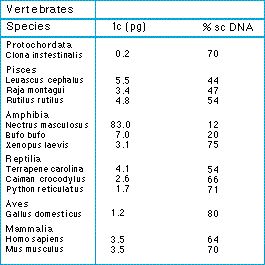Molecular and Mendelian Genetics - Is there non-coding DNA?

Non-coding DNA
Much of the DNA in many species probably does not produce or regulate the production of proteins. It is therefore called non-coding DNA.
For example, the human genome is about 3 x 109 nucleotide pairs long, and some geneticists estimate that only 10 - 25% of it is actually coding DNA. It has been observed that bacterial DNA tends to be much more economically organized.
DNA reassociation experiments let us estimate the proportion of non coding DNA. In these experiments, strands of DNA are allowed to join together (reassociate) and the rate at which they do depends upon their sequence similarity. The parts of the DNA which reassociate quickly mainly consist of highly repetitive DNA, made up of large numbers of repeats of simple sequences. The DNA that joined together slowly was 'single copy' DNA, the part of the DNA which encodes for most of the genes.
The table opposite lists the genome sizes and proportion of single copy DNA of a number of species.
Table: amount of DNA and percentage of single copy DNA (sc DNA) in various animal species. Amount of DNA is expressed as haploid DNA content, 1C in picograms. From John and Miklos (1988).
| Next |



